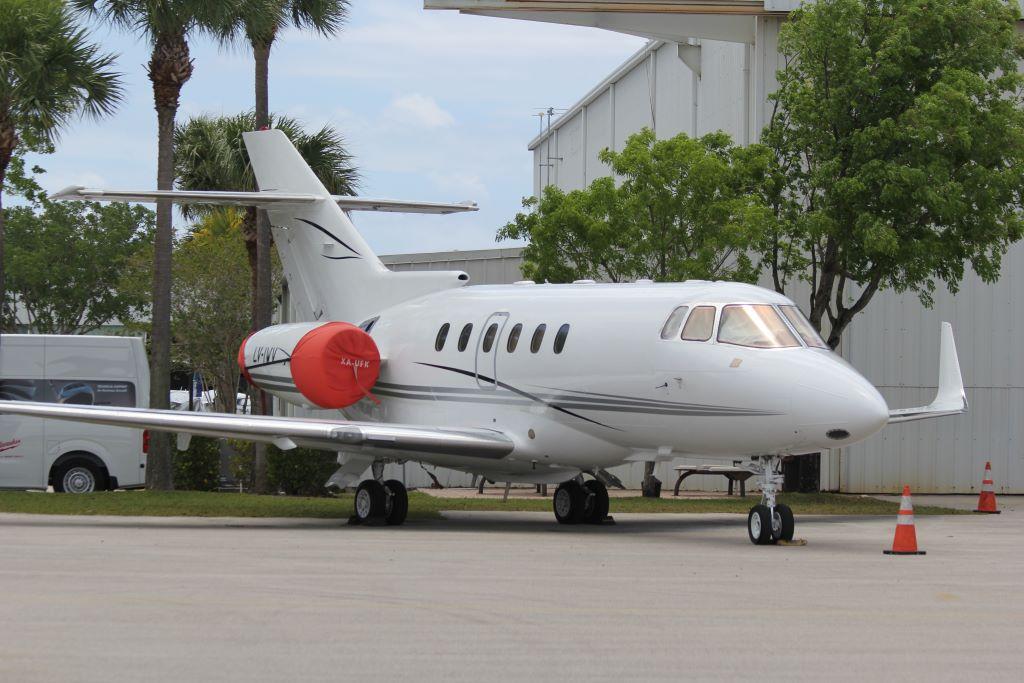
Nearing two decades since its production run ended, the Hawker 800XP continues to hold value in the pre-owned market as a workhorse midsize jet with a spacious cabin and U.S. coast-to-coast range.
Raytheon introduced the XP version of the Hawker 800 A/B models with increased-thrust Honeywell TFE731-5BR engines in 1995 and built it through 2005, after which the improved, winglet-equipped 850XP entered service. The 4,750-lb. thrust turbofans on the 800XP each produce 250 lb. of additional thrust, according to Honeywell specifications.
There have been various versions and designations of the twinjet. The Hawker 800XP2 has aftermarket Aviation Partners’ Scimitar-tip Blended Winglets, estimated to cut fuel consumption by up to 7%. The 800XPR upgrade came with Hawker Beechcraft’s own winglets and Honeywell TFE731-50R engines. The Japan Air Self-Defense Force operated the U-125A, a military search-and-rescue variant of the Hawker 800.
As of early July, there were 28 Hawker 800XPs for sale, representing 7.2% of the active fleet, said Mitch McCune, president and CEO of CFSJets, an International Aircraft Dealers Association-accredited dealer based in Cornelius, North Carolina. They were selling in the lower-to-upper $1 million range, depending on their avionics.
The 2005-model-year Hawker 800XP sold new for $12.9 million, with an average equipped price of $13.2 million, according to the summer 2021 issue of the Aircraft Bluebook, which lists a current average retail price of $1.7 million.
The 800XP has a maximum range of 2,470 nm, carries up to eight passengers and two crew and can fly four passengers to range and land with NBAA IFR fuel reserves. Long-range cruise speed is 402 ktas. Departing at MTOW (28,000 lb.), the twinjet needs 5,030 ft. of runway in standard-day ISA conditions.
“The aircraft is very pleasant to fly, featuring moderate control forces in all three axes and excellent control harmony,” former BCA senior editor and chief pilot Fred George wrote in 2018. “It is especially easy to handle during engine-out conditions because of its bleed air bias rudder boost system.”
The XP designation “is a relative term as the Hawker 800XP still has matronly performance compared to many other midsize aircraft,” added George. “While standard-day takeoff field length is a respectable 5,030 ft., it needs 8,800 ft. of runway when departing BCA’s 5,000-ft. elevation, ISA+20C airport. Above that density altitude, there are significant weight/altitude/temperature tradeoffs.”
The Hawker 800XP accommodates eight passengers in four-chair club seating forward, with a single seat and three-seat divan aft; an option was available that eliminated the divan and provided six individual seats. “The six-passenger configuration is not preferred and does have a negative effect on resale with respect to both price and the time to sell,” said McCune.
The cabin is 6 ft. wide, 5.75 ft. in height and 21.3 ft. long. Cabin altitude at the 800XP’s maximum certified altitude (41,000 ft.) is 7,500 ft., according to Conklin & deDecker. Passengers appreciate a “very spacious, stand-up cabin that provides a large aft lavatory and a full-service forward galley,” said McCune.
Since 2002, Hawker 800XPs came standard with the Rockwell Collins (now Collins Aerospace) Pro Line 21 avionics suite, replacing the Pro Line 4 or Honeywell SPZ-8000 systems on earlier models. More recently, Redimec, a Universal Avionics-authorized dealer based in Argentina, has developed a supplemental type certificate, which it makes available for purchase to other dealers, enabling 800XP operators to upgrade to Universal’s InSight flight deck.
The Insight retrofit “replaces aging, obsolescent and high-failure rate equipment with a clean, streamlined and reliable flight deck,” says Universal. System components include dual, satellite-navigation-capable UNS-1Fw flight management systems, integrated with three 10.4-in. diagonal EFI-1040 displays, two touchscreen EFIS Control Display Units, two alphanumeric keyboards for tactile user inputs, and a reference select panel with dedicated knobs for altitude select, heading select and other values.
Most of the recent sales activity has focused on later Pro Line 21-equipped aircraft, said McCune. “Direct competition for the 800XP has always been the Falcon 50EX and Gulfstream G150,” he said.
Conklin & deDecker estimates Hawker 800XP operating variable cost of $3,400 per flight hour. Basic A, B, C and D inspections of the jet are due at 400-, 800-, 1,600- and 3,200-hr. intervals. Calendar E, F and G inspections are due at 12, 24 and 48 months, plus a 96-month X-ray structural inspection. There is a structural inspection at 1,200 hr. for aircraft that have logged more than 4,800 flight hr.





